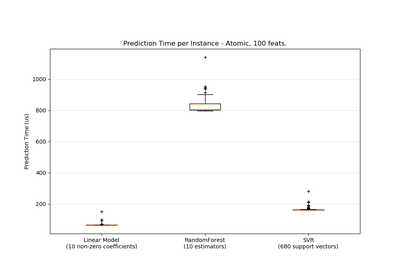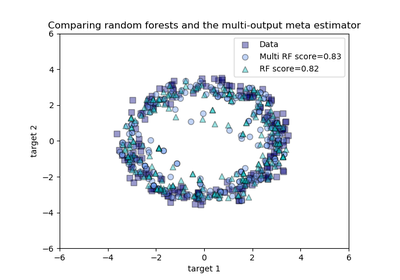3.2.4.3.2. sklearn.ensemble.RandomForestRegressor¶
-
class
sklearn.ensemble.RandomForestRegressor(n_estimators=10, criterion=’mse’, max_depth=None, min_samples_split=2, min_samples_leaf=1, min_weight_fraction_leaf=0.0, max_features=’auto’, max_leaf_nodes=None, min_impurity_decrease=0.0, min_impurity_split=None, bootstrap=True, oob_score=False, n_jobs=1, random_state=None, verbose=0, warm_start=False)[source]¶ A random forest regressor.
A random forest is a meta estimator that fits a number of classifying decision trees on various sub-samples of the dataset and use averaging to improve the predictive accuracy and control over-fitting. The sub-sample size is always the same as the original input sample size but the samples are drawn with replacement if bootstrap=True (default).
Read more in the User Guide.
Parameters: n_estimators : integer, optional (default=10)
The number of trees in the forest.
criterion : string, optional (default=”mse”)
The function to measure the quality of a split. Supported criteria are “mse” for the mean squared error, which is equal to variance reduction as feature selection criterion, and “mae” for the mean absolute error.
New in version 0.18: Mean Absolute Error (MAE) criterion.
max_features : int, float, string or None, optional (default=”auto”)
The number of features to consider when looking for the best split:
- If int, then consider max_features features at each split.
- If float, then max_features is a percentage and int(max_features * n_features) features are considered at each split.
- If “auto”, then max_features=n_features.
- If “sqrt”, then max_features=sqrt(n_features).
- If “log2”, then max_features=log2(n_features).
- If None, then max_features=n_features.
Note: the search for a split does not stop until at least one valid partition of the node samples is found, even if it requires to effectively inspect more than
max_featuresfeatures.max_depth : integer or None, optional (default=None)
The maximum depth of the tree. If None, then nodes are expanded until all leaves are pure or until all leaves contain less than min_samples_split samples.
min_samples_split : int, float, optional (default=2)
The minimum number of samples required to split an internal node:
- If int, then consider min_samples_split as the minimum number.
- If float, then min_samples_split is a percentage and ceil(min_samples_split * n_samples) are the minimum number of samples for each split.
Changed in version 0.18: Added float values for percentages.
min_samples_leaf : int, float, optional (default=1)
The minimum number of samples required to be at a leaf node:
- If int, then consider min_samples_leaf as the minimum number.
- If float, then min_samples_leaf is a percentage and ceil(min_samples_leaf * n_samples) are the minimum number of samples for each node.
Changed in version 0.18: Added float values for percentages.
min_weight_fraction_leaf : float, optional (default=0.)
The minimum weighted fraction of the sum total of weights (of all the input samples) required to be at a leaf node. Samples have equal weight when sample_weight is not provided.
max_leaf_nodes : int or None, optional (default=None)
Grow trees with
max_leaf_nodesin best-first fashion. Best nodes are defined as relative reduction in impurity. If None then unlimited number of leaf nodes.min_impurity_split : float,
Threshold for early stopping in tree growth. A node will split if its impurity is above the threshold, otherwise it is a leaf.
Deprecated since version 0.19:
min_impurity_splithas been deprecated in favor ofmin_impurity_decreasein 0.19 and will be removed in 0.21. Usemin_impurity_decreaseinstead.min_impurity_decrease : float, optional (default=0.)
A node will be split if this split induces a decrease of the impurity greater than or equal to this value.
The weighted impurity decrease equation is the following:
N_t / N * (impurity - N_t_R / N_t * right_impurity - N_t_L / N_t * left_impurity)
where
Nis the total number of samples,N_tis the number of samples at the current node,N_t_Lis the number of samples in the left child, andN_t_Ris the number of samples in the right child.N,N_t,N_t_RandN_t_Lall refer to the weighted sum, ifsample_weightis passed.New in version 0.19.
bootstrap : boolean, optional (default=True)
Whether bootstrap samples are used when building trees.
oob_score : bool, optional (default=False)
whether to use out-of-bag samples to estimate the R^2 on unseen data.
n_jobs : integer, optional (default=1)
The number of jobs to run in parallel for both fit and predict. If -1, then the number of jobs is set to the number of cores.
random_state : int, RandomState instance or None, optional (default=None)
If int, random_state is the seed used by the random number generator; If RandomState instance, random_state is the random number generator; If None, the random number generator is the RandomState instance used by np.random.
verbose : int, optional (default=0)
Controls the verbosity of the tree building process.
warm_start : bool, optional (default=False)
When set to
True, reuse the solution of the previous call to fit and add more estimators to the ensemble, otherwise, just fit a whole new forest.Attributes: estimators_ : list of DecisionTreeRegressor
The collection of fitted sub-estimators.
feature_importances_ : array of shape = [n_features]
The feature importances (the higher, the more important the feature).
n_features_ : int
The number of features when
fitis performed.n_outputs_ : int
The number of outputs when
fitis performed.oob_score_ : float
Score of the training dataset obtained using an out-of-bag estimate.
oob_prediction_ : array of shape = [n_samples]
Prediction computed with out-of-bag estimate on the training set.
See also
DecisionTreeRegressor,ExtraTreesRegressorNotes
The default values for the parameters controlling the size of the trees (e.g.
max_depth,min_samples_leaf, etc.) lead to fully grown and unpruned trees which can potentially be very large on some data sets. To reduce memory consumption, the complexity and size of the trees should be controlled by setting those parameter values.The features are always randomly permuted at each split. Therefore, the best found split may vary, even with the same training data,
max_features=n_featuresandbootstrap=False, if the improvement of the criterion is identical for several splits enumerated during the search of the best split. To obtain a deterministic behaviour during fitting,random_statehas to be fixed.References
[R167] - Breiman, “Random Forests”, Machine Learning, 45(1), 5-32, 2001.
Examples
>>> from sklearn.ensemble import RandomForestRegressor >>> from sklearn.datasets import make_regression >>> >>> X, y = make_regression(n_features=4, n_informative=2, ... random_state=0, shuffle=False) >>> regr = RandomForestRegressor(max_depth=2, random_state=0) >>> regr.fit(X, y) RandomForestRegressor(bootstrap=True, criterion='mse', max_depth=2, max_features='auto', max_leaf_nodes=None, min_impurity_decrease=0.0, min_impurity_split=None, min_samples_leaf=1, min_samples_split=2, min_weight_fraction_leaf=0.0, n_estimators=10, n_jobs=1, oob_score=False, random_state=0, verbose=0, warm_start=False) >>> print(regr.feature_importances_) [ 0.17339552 0.81594114 0. 0.01066333] >>> print(regr.predict([[0, 0, 0, 0]])) [-2.50699856]
Methods
apply(X)Apply trees in the forest to X, return leaf indices. decision_path(X)Return the decision path in the forest fit(X, y[, sample_weight])Build a forest of trees from the training set (X, y). get_params([deep])Get parameters for this estimator. predict(X)Predict regression target for X. score(X, y[, sample_weight])Returns the coefficient of determination R^2 of the prediction. set_params(**params)Set the parameters of this estimator. -
__init__(n_estimators=10, criterion=’mse’, max_depth=None, min_samples_split=2, min_samples_leaf=1, min_weight_fraction_leaf=0.0, max_features=’auto’, max_leaf_nodes=None, min_impurity_decrease=0.0, min_impurity_split=None, bootstrap=True, oob_score=False, n_jobs=1, random_state=None, verbose=0, warm_start=False)[source]¶
-
apply(X)[source]¶ Apply trees in the forest to X, return leaf indices.
Parameters: X : array-like or sparse matrix, shape = [n_samples, n_features]
The input samples. Internally, its dtype will be converted to
dtype=np.float32. If a sparse matrix is provided, it will be converted into a sparsecsr_matrix.Returns: X_leaves : array_like, shape = [n_samples, n_estimators]
For each datapoint x in X and for each tree in the forest, return the index of the leaf x ends up in.
-
decision_path(X)[source]¶ Return the decision path in the forest
New in version 0.18.
Parameters: X : array-like or sparse matrix, shape = [n_samples, n_features]
The input samples. Internally, its dtype will be converted to
dtype=np.float32. If a sparse matrix is provided, it will be converted into a sparsecsr_matrix.Returns: indicator : sparse csr array, shape = [n_samples, n_nodes]
Return a node indicator matrix where non zero elements indicates that the samples goes through the nodes.
n_nodes_ptr : array of size (n_estimators + 1, )
The columns from indicator[n_nodes_ptr[i]:n_nodes_ptr[i+1]] gives the indicator value for the i-th estimator.
-
feature_importances_¶ - Return the feature importances (the higher, the more important the
- feature).
Returns: feature_importances_ : array, shape = [n_features]
-
fit(X, y, sample_weight=None)[source]¶ Build a forest of trees from the training set (X, y).
Parameters: X : array-like or sparse matrix of shape = [n_samples, n_features]
The training input samples. Internally, its dtype will be converted to
dtype=np.float32. If a sparse matrix is provided, it will be converted into a sparsecsc_matrix.y : array-like, shape = [n_samples] or [n_samples, n_outputs]
The target values (class labels in classification, real numbers in regression).
sample_weight : array-like, shape = [n_samples] or None
Sample weights. If None, then samples are equally weighted. Splits that would create child nodes with net zero or negative weight are ignored while searching for a split in each node. In the case of classification, splits are also ignored if they would result in any single class carrying a negative weight in either child node.
Returns: self : object
Returns self.
-
get_params(deep=True)[source]¶ Get parameters for this estimator.
Parameters: deep : boolean, optional
If True, will return the parameters for this estimator and contained subobjects that are estimators.
Returns: params : mapping of string to any
Parameter names mapped to their values.
-
predict(X)[source]¶ Predict regression target for X.
The predicted regression target of an input sample is computed as the mean predicted regression targets of the trees in the forest.
Parameters: X : array-like or sparse matrix of shape = [n_samples, n_features]
The input samples. Internally, its dtype will be converted to
dtype=np.float32. If a sparse matrix is provided, it will be converted into a sparsecsr_matrix.Returns: y : array of shape = [n_samples] or [n_samples, n_outputs]
The predicted values.
-
score(X, y, sample_weight=None)[source]¶ Returns the coefficient of determination R^2 of the prediction.
The coefficient R^2 is defined as (1 - u/v), where u is the residual sum of squares ((y_true - y_pred) ** 2).sum() and v is the total sum of squares ((y_true - y_true.mean()) ** 2).sum(). The best possible score is 1.0 and it can be negative (because the model can be arbitrarily worse). A constant model that always predicts the expected value of y, disregarding the input features, would get a R^2 score of 0.0.
Parameters: X : array-like, shape = (n_samples, n_features)
Test samples.
y : array-like, shape = (n_samples) or (n_samples, n_outputs)
True values for X.
sample_weight : array-like, shape = [n_samples], optional
Sample weights.
Returns: score : float
R^2 of self.predict(X) wrt. y.
-
set_params(**params)[source]¶ Set the parameters of this estimator.
The method works on simple estimators as well as on nested objects (such as pipelines). The latter have parameters of the form
<component>__<parameter>so that it’s possible to update each component of a nested object.Returns: self :




